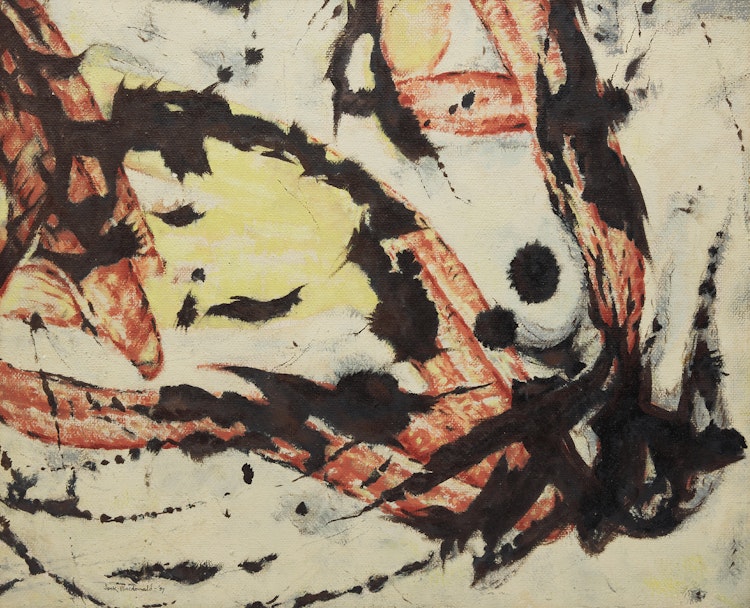The Butterfly, 1957 by James Williamson Galloway Macdonald

Jock Macdonald
The Butterfly, 1957
oil and lucite on board
signed and dated 1957 lower left; titled on the reverse
20 x 24 in ( 50.8 x 61 cm )
Auction Estimate: $10,000.00 - $15,000.00
Price Realized $11,400.00
Sale date: November 27th 2024
Private Collection, Ontario
By descent to a Private Collection, British Columbia
Waddington's, auction, Toronto, 21 November 2016, lot 99
Estate of Robert Noakes
Joyce Zemans, "Jock Macdonald: 1897-1960," Ottawa, 1985, reproduced page 45, pages 7, 24
Joyce Zemans, "Jock Macdonald: Life & Work" [online publication], Art Canada Institute, Toronto, 2016, page 61
In 1957, Macdonald created "The Butterfly," inspired by a watercolour and ink piece of the same name that he had painted a year earlier. He was able to achieve nearly the same effect in this new medium. Macdonald himself remarked that “using Lucite with oil allowed me to paint with a flow and speed, but without being careless.”
Zemans also recounts that in January 1958, the renowned New York art critic Clement Greenberg, a mentor to many Color Field painters, praised Macdonald’s recent work, saying it was “reaching the highest levels.” "The Butterfly" emerged from this pivotal period in which Macdonald experienced newfound creative freedom.
Share this item with your friends
James Williamson Galloway Macdonald
(1897 - 1960) Painters Eleven, Canadian Group of Painters,
Jock Macdonald was born on May 31, 1897 in Thurso, Scotland. A graduate of the Edinburgh College of Art, Macdonald emigrated to Canada in 1927 to become head of design and instructor in commercial advertising at the newly established Vancouver School of Decorative and Applied Arts (now the Emily Carr Institute of Art and Design). Inspired by the natural environment, Macdonald and his colleague Frederick Varley, head of drawing, painting, and composition, spent much of their free time on weekends and summer vacations on sketching and camping trips in the Garibaldi Mountains. When the Depression forced severe salary cuts in the art school budget, Macdonald and Varley decided to found the B.C. College of Art. It quickly established a reputation as a centre of new and stimulating ideas in a variety of art forms including music, dance and photography as well as the visual arts. The school operated for two years before declaring bankruptcy, but its influence on the local cultural community of the period is now legendary. Macdonald himself was infected by the exciting ideas fostered at the College and he began experiments in abstraction. He soon found landscape painting in the tradition of his Group of Seven contemporaries too confining whereas abstraction opened up new vistas of expressive freedom. During his twenty years in B.C., Macdonald was active as artist, teacher, exhibitor, and arts organizer. He was a member of the B.C. Society of Artists, with whom he exhibited regularly; a charter member of the Federation of Canadian Artists; and a member of the Vancouver Art Gallery Council for eleven years, serving on its judging, exhibitions and hanging committees, and implementing its popular Saturday morning classes. The Vancouver Art Gallery accorded Macdonald his first one man show in May 1941 and five years later mounted a solo exhibition, of his "automatic" watercolours. Macdonald moved to Toronto in 1947 and became instructor of painting at the Ontario College of Art. In 1953 he was instrumental in the founding of Painters Eleven, a group dedicated to the promotion of abstract art. He wrote later: "In training young students I believe it absolutely necessary that the student be provided a program of study which forces him to observe nature very closely in many diverse directions. After some two years of such study I encourage the student to expand his inner self and begin to expand his personality. I am quite aware that the young student is often intuitively aware of his consciousness of the twentieth century and could create in modern ways but I believe that every student should, first of all, increase his vocabulary of form and colours by observing nature forms and be initiated into the laws of balance and dynamic equilibrium." Jock Macdonald died at the age of 63 on December 3, 1960.

